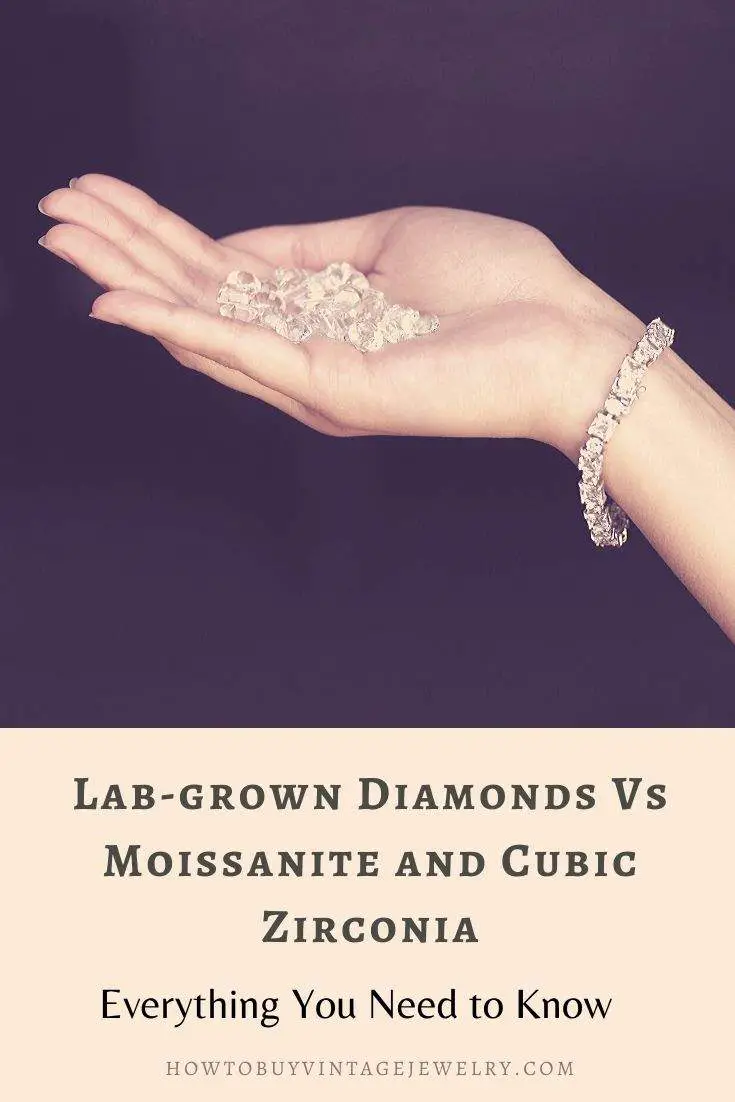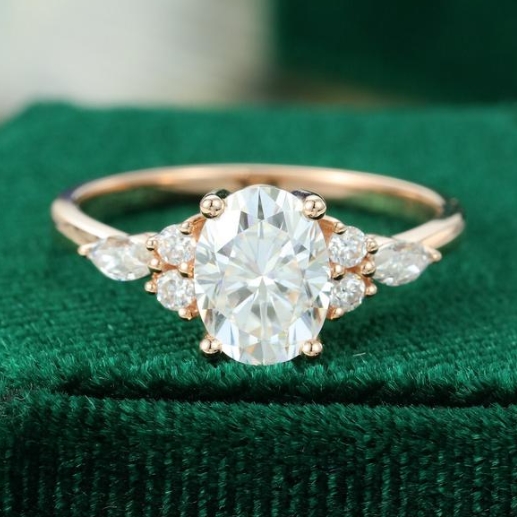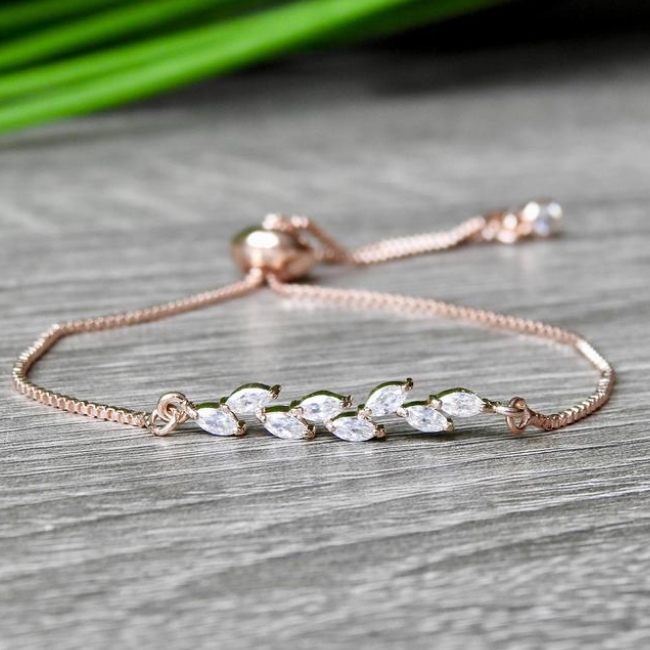Hey There! We may earn a commission from links on this page. This helps support the site and is at no extra cost to you. Thanks!

When you go shopping for that special piece of jewelry, “diamond” often comes to mind. It is, after all, long admired and desired all over the world. But there are alternatives to traditional mined diamonds: lab-grown diamonds, moissanite and cubic zirconia. While they look similar, they are very different. In this article we will cover lab-grown diamonds vs moissanite and cubic zirconia. Learn the differences before you go shopping. We have here an overview of each type of stone.
Firstly, however, there are three important things that the three have in common. They all originate in a laboratory; they all are superior ethically and environmentally to mined diamonds; and they all cost less than mined diamonds.
Lab-Grown Diamonds
The most important thing to know about lab-grown diamonds is that they are real diamonds. They differ only in that they originate in a laboratory instead of deep within the earth. Lab-grown diamonds are 100% pure crystallized carbon and are identical in every way, optically, chemically and physically, to a mined diamond. They are as dazzling as mined diamonds with the same fire, scintillation and sparkle. Even professionals cannot distinguish them from mined diamonds without the specialized equipment that can detect microscopic differences.
Lab-grown diamonds are less expensive than mined, but make no mistake, they are not cheap. They may be 20% to 30% less expensive than mined. Not due to inferiority but due to a shorter supply chain. It’s easier to get a diamond from a lab than it is from a mine!
Lab created diamonds do tend to have a much lower re-sell price, and not hold their value as well as natural diamonds.
Tip: If you are shopping for real or lab-grown diamond jewelry, we recommend shopping at an online retailer where you can see the actual stone before the purchase. James Allen allows you to see each loose diamond from all sides with its 360-degree diamond display technology.
Moissanite
Moissanite was discovered in 1893 by Henry Moissan in a crater left by a meteorite strike in Arizona. He thought the particles were diamonds until he saw that they were made up of silicon carbide instead of carbon. Natural moissanite is extremely rare, found only where meteorites have struck the earth. All moissanite found on the market today is lab-created.
Moissanite is a stunningly beautiful gemstone, and it is becoming more and more popular as an alternative to a diamond. Its cost and dazzle alone are influencing the jewelry-buying public. With its white color, brilliant sparkle, and mesmerizing facets, moissanite is not trying to be a diamond. It is lovely enough as itself, with a higher level of fire and brilliance than a diamond. In fact, its fire exceeds that of any popular gemstone, not only diamonds. It also can last a lifetime and retain its clarity; it is second only to diamonds on the hardness scale.
A major difference in the moissanite is that the pattern of facets creates a rainbow-like effect.
When light enters the stone, a spectrum of colors reflects back to the viewer, making it more attractive to some buyers. Others compare it (scornfully) to a disco ball. For those who love that ultra-sparkle and have a limited budget, moissanite is definitely an option. It costs about 70% less than lab-grown diamonds.

Moissanite Engagement Ring from Molly Jewelry US on Etsy
Cubic Zirconia
German mineralogists discovered naturally occurring cubic zirconia (CZ), but it is very rare. It also is inferior to the CZ we know. In the 1960s, the Soviets perfected the manufacture of CZ for commercial purposes, including for jewelry.
CZ is a low-cost alternative to a diamond. It is a crystal cut in a way to simulate a diamond and is not chemically, physically or optically like a diamond and will rarely, if ever, be mistaken for one. Nor will it be mistaken for a moissanite. A CZ is much softer than both diamond and moissanite. It scratches easily and will cloud over time. Faceted CZ stones have rounded edges that become more rounded as the material wears out—and it will wear out eventually.
We are not trying to talk you out of CZ. It has its good points. It is perfectly transparent and perfectly white, and it has that same rainbow effect as moissanite. It’s up to individual taste. And it has its place. Such as when you want something beautiful for yourself or a loved one. Maybe you have your heart set on a certain size stone. Better a CZ than putting off the gift indefinitely. There is no shame. It’s a beautiful stone. Your love is real. As your fortunes improve, you will be able to upgrade. CZ is also good if you want to “downgrade,” have your expensive jewelry recreated for, say, when you travel. The rich and famous do it all the time. CZ is one-tenth the cost of moissanite.

Dainty Rose Gold Bracelet with Cubic Zirconia by So Splashy Designs on Etsy
Optical Differences - lab-grown diamonds vs moissanite and cubic zirconia
The brilliance and fire of these stones sets them apart from each other.
Brilliance is closely related to the refractive index of the material. Moissanite it is around 2.7, which is considerably larger than the refractive index of diamond (2.4) or cubic zirconia (2.15).
Fire refers to the properties of dispersing light. Moissanite has a dispersion of 0.1, which is considerably larger than cubic zirconia at a dispersion of 0.06. Both have a larger fire than diamond with its merely 0.04.
Hardness of Lab-Grown Diamonds, Moissanite, and Cubic Zirconia
These stones have differences in their hardness or how durable they are. Diamonds are the most durable, with a hardness rating of 10. Moissanite is very close, with a hardness of 9.2, while cubiz zirconia has a hardness level of 8 - 8.5.
Toughness is another durability factor to consider. Toughness refers to the resistance to breaking, and moissanite trumps cubic zirconia in this department. Moissanite has a toughness rating of 7.6, while cubic zirconia has a toughness rating of 2.4.

Summary: lab-grown diamonds vs moissanite and cubic zirconia
There are a lot of things to consider when choosing between moisannite, CZ, and lab-grown diamonds. It boils down to what fits your tastes, needs and budget. Here we will give you a “cheat sheet” of sorts to simplify the differences between the three.
Moissanite Pros:
- It is the harder than CZ, which means it is more likely to last a lifetime.
- It is “tougher" than CZ meaning less likely to chip or break.
- It is resistant to dirt, including cosmetics, oils and powders, accumulates it less easily and, therefore, retains its shine longer.
- It has a much higher brilliance and fire—not only higher than a CZ but also a diamond.
- Moissanite is a better diamond alternative for an engagement ring than cubic zirconia.
CZ Pros:
- It costs about one-tenth of the cost moissanite. Think $40 instead of $400.
- It jewelry is “a girl’s best friend,” you can have more friends with CZ, more variety, more “outfit specific” pieces.
- It has a higher dispersion than moissanite, and, to some, the rainbow effect reflecting off the stone is more beautiful. To others, it has too much color.
- Its clarity is flawless, not something moissanite can achieve.
- It comes in jewel tones to simulate rubies, emeralds and sapphires.
- We recommend CZ for fun and casual jewerly, rather than something like an engagement ring.
Lab-Grown Diamond Pros:
- These are real diamonds at a fraction of the price.
- Harder than any other mineral, meaning they are extremely durable.
- They will retain their sparkle and shine for lifetimes.
- Lab-grown diamonds are more affordable than naturally mined diamonds, with the same properties.
- They are becoming easier to find and purchase.
James Allen is an online retailer that allows you to see a diamond from all sides with its 360-degree technology. Click to see their earth-created diamonds and lab-created diamonds.
Visit the Etsy pages to see large selections of moissanite and cubic zirconia.
